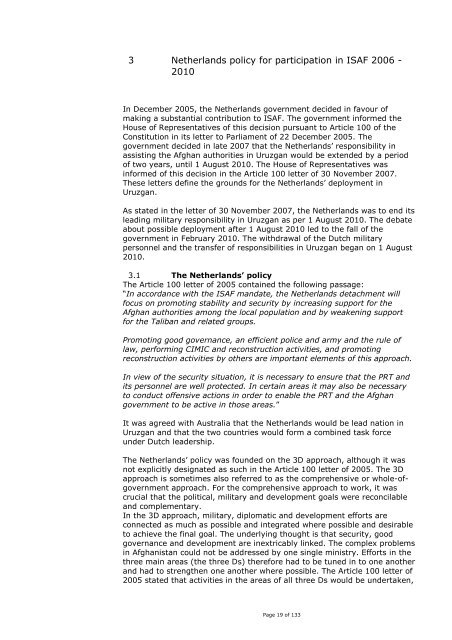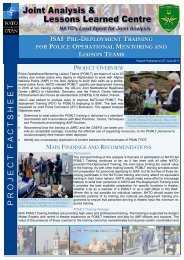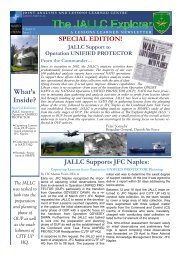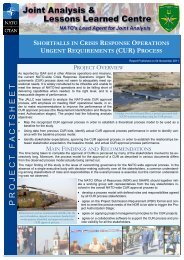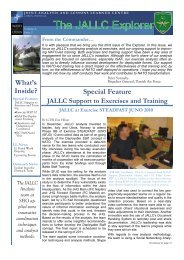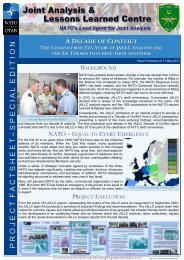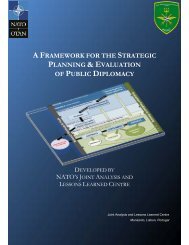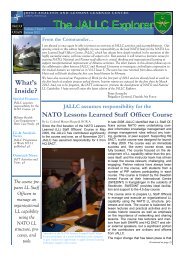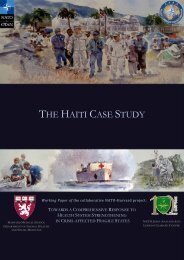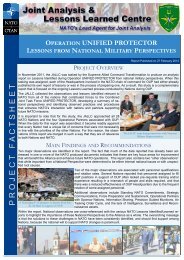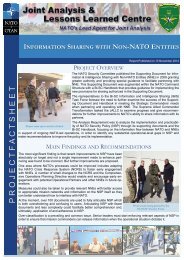The <strong>ISAF</strong> leadership <strong>in</strong>cluded a US subord<strong>in</strong>ate commander who, along withhis function <strong>in</strong> <strong>ISAF</strong>, was <strong>in</strong> command of the deployment of OEF units. AfterNATO had taken over command of <strong>ISAF</strong> and its area of operations wasexpand<strong>in</strong>g across Afghanistan, it became essential to coord<strong>in</strong>ate anddeconflict OEF’s and <strong>ISAF</strong>’s activities. Particularly the security of theparticipat<strong>in</strong>g units was important. The OEF units did not fall under thecommand of NATO, but nonetheless operated with<strong>in</strong> <strong>ISAF</strong>’s area ofresponsibility. From 2001, the <strong>Netherlands</strong> made several contributions toOEF <strong>in</strong> Afghanistan, for different periods of time and with variouscompositions, participat<strong>in</strong>g with special units, transport helicopters, F-16fighter aircraft, a tanker aircraft, a transport aircraft, a maritime patrolaircraft, and liaison officers at various locations. 52.4 <strong>Netherlands</strong> and <strong>ISAF</strong>The <strong>Netherlands</strong> has been <strong>in</strong>volved <strong>in</strong> <strong>ISAF</strong> from the start. Initially, this<strong>in</strong>volvement consisted of an <strong>in</strong>fantry company and support, a CommandoCorps platoon, contributions to <strong>in</strong>ternational staffs, the deployment of an F-16 unit and f<strong>in</strong>ancial contributions. In 2003, the staff of the German-<strong>Netherlands</strong> Corps formed the core of the <strong>ISAF</strong> headquarters <strong>in</strong> Kabul. In2004 and 2005, the <strong>Netherlands</strong> supplied an Apache detachment. From2004 through <strong>2006</strong>, the <strong>Netherlands</strong> supplied a PRT <strong>in</strong> the prov<strong>in</strong>ce ofBaghlan <strong>in</strong> the north of Afghanistan. In 2005, the <strong>Netherlands</strong> provided anElection Support Force for the elections that were held <strong>in</strong> September of thatyear, and from the same year it supplied an F-16 detachment, supported bya KDC-10 tanker and transport aircraft. From <strong>2006</strong>, as <strong>ISAF</strong> deployed tosouthern Afghanistan, the <strong>Netherlands</strong> took up command of <strong>ISAF</strong>operations <strong>in</strong> the prov<strong>in</strong>ce of Uruzgan. Uruzgan came under the area ofresponsibility of <strong>ISAF</strong>’s Regional Command South (RC-S), along with theprov<strong>in</strong>ces of Helmand, Kandahar, Nimruz, Daykundi and Zabul. The otherlead nations <strong>in</strong> the south were Canada, the United States and the UnitedK<strong>in</strong>gdom. Prior to and dur<strong>in</strong>g the mission, consultations with these partnersabout what approach should be taken <strong>in</strong> RC-S were held at adm<strong>in</strong>istrativeand m<strong>in</strong>isterial levels.5 Parliamentary Document 27925 No 28 of 6 December 2001, and follow<strong>in</strong>g.Page 18 of 133
3 <strong>Netherlands</strong> policy for <strong>participation</strong> <strong>in</strong> <strong>ISAF</strong> <strong>2006</strong> -<strong>2010</strong>In December 2005, the <strong>Netherlands</strong> government decided <strong>in</strong> favour ofmak<strong>in</strong>g a substantial contribution to <strong>ISAF</strong>. The government <strong>in</strong>formed theHouse of Representatives of this decision pursuant to Article 100 of theConstitution <strong>in</strong> its letter to Parliament of 22 December 2005. Thegovernment decided <strong>in</strong> late 2007 that the <strong>Netherlands</strong>’ responsibility <strong>in</strong>assist<strong>in</strong>g the Afghan authorities <strong>in</strong> Uruzgan would be extended by a periodof two years, until 1 August <strong>2010</strong>. The House of Representatives was<strong>in</strong>formed of this decision <strong>in</strong> the Article 100 letter of 30 November 2007.These letters def<strong>in</strong>e the grounds for the <strong>Netherlands</strong>’ deployment <strong>in</strong>Uruzgan.As stated <strong>in</strong> the letter of 30 November 2007, the <strong>Netherlands</strong> was to end itslead<strong>in</strong>g military responsibility <strong>in</strong> Uruzgan as per 1 August <strong>2010</strong>. The debateabout possible deployment after 1 August <strong>2010</strong> led to the fall of thegovernment <strong>in</strong> February <strong>2010</strong>. The withdrawal of the Dutch militarypersonnel and the transfer of responsibilities <strong>in</strong> Uruzgan began on 1 August<strong>2010</strong>.3.1 The <strong>Netherlands</strong>’ policyThe Article 100 letter of 2005 conta<strong>in</strong>ed the follow<strong>in</strong>g passage:“In accordance with the <strong>ISAF</strong> mandate, the <strong>Netherlands</strong> detachment willfocus on promot<strong>in</strong>g stability and security by <strong>in</strong>creas<strong>in</strong>g support for theAfghan authorities among the local population and by weaken<strong>in</strong>g supportfor the Taliban and related groups.Promot<strong>in</strong>g good governance, an efficient police and army and the rule oflaw, perform<strong>in</strong>g CIMIC and reconstruction activities, and promot<strong>in</strong>greconstruction activities by others are important elements of this approach.In view of the security situation, it is necessary to ensure that the PRT andits personnel are well protected. In certa<strong>in</strong> areas it may also be necessaryto conduct offensive actions <strong>in</strong> order to enable the PRT and the Afghangovernment to be active <strong>in</strong> those areas.”It was agreed with Australia that the <strong>Netherlands</strong> would be lead nation <strong>in</strong>Uruzgan and that the two countries would form a comb<strong>in</strong>ed task forceunder Dutch leadership.The <strong>Netherlands</strong>’ policy was founded on the 3D approach, although it wasnot explicitly designated as such <strong>in</strong> the Article 100 letter of 2005. The 3Dapproach is sometimes also referred to as the comprehensive or whole-ofgovernmentapproach. For the comprehensive approach to work, it wascrucial that the political, military and development goals were reconcilableand complementary.In the 3D approach, military, diplomatic and development efforts areconnected as much as possible and <strong>in</strong>tegrated where possible and desirableto achieve the f<strong>in</strong>al goal. The underly<strong>in</strong>g thought is that security, goodgovernance and development are <strong>in</strong>extricably l<strong>in</strong>ked. The complex problems<strong>in</strong> Afghanistan could not be addressed by one s<strong>in</strong>gle m<strong>in</strong>istry. Efforts <strong>in</strong> thethree ma<strong>in</strong> areas (the three Ds) therefore had to be tuned <strong>in</strong> to one anotherand had to strengthen one another where possible. The Article 100 letter of2005 stated that activities <strong>in</strong> the areas of all three Ds would be undertaken,Page 19 of 133
- Page 1 and 2: Final evaluationNetherlands contrib
- Page 3 and 4: High mountainsLow mountainsPlains a
- Page 5 and 6: Table of ContentsDutch military per
- Page 7 and 8: Dutch military personnel deceased i
- Page 9 and 10: Page 9 of 133
- Page 11 and 12: 1 IntroductionThe government would,
- Page 13 and 14: The structure of the final evaluati
- Page 15 and 16: 2 The international presence in Afg
- Page 17: insurgents in, particularly, the ea
- Page 21 and 22: Netherlands’ presence. Furthermor
- Page 23 and 24: “The objectives of this stabilisa
- Page 25 and 26: In December 2005, the Netherlands g
- Page 27 and 28: The expectation is that meaningful
- Page 29 and 30: 3.6.2 Implementation of national pr
- Page 31 and 32: 4 Implementation of the mission and
- Page 33 and 34: tasks to fulfil in the area of secu
- Page 35 and 36: such as the Bushmaster, that was be
- Page 37 and 38: Afghan partner unit, at all times o
- Page 39 and 40: northern part of Deh Rawod in 2007.
- Page 41 and 42: in large and small bases, while con
- Page 43 and 44: previously thought and comprised a
- Page 45 and 46: Apart from facilitating training an
- Page 47 and 48: If operations in close proximity of
- Page 49 and 50: As previously mentioned, the preven
- Page 51 and 52: - Between 2006 and 2010, the number
- Page 53 and 54: government of Chora in January 2010
- Page 55 and 56: At the beginning of the Dutch missi
- Page 57 and 58: intermediary of TLO and political a
- Page 59 and 60: interest for filling judicial posit
- Page 61 and 62: During the Uruzgan mission, a great
- Page 63 and 64: structurally change governance in U
- Page 65 and 66: development programmes. Before the
- Page 67 and 68: also the way in which Afghans perce
- Page 69 and 70:
tailored to the real needs of the p
- Page 71 and 72:
Gizab had increased and there was a
- Page 73 and 74:
The DCU programme devoted and still
- Page 75 and 76:
purpose of these loans, cooperative
- Page 77 and 78:
In view of the lack of enthusiasm a
- Page 79 and 80:
5 Expenditure for the mission and i
- Page 81 and 82:
Overview of long-term expenditure a
- Page 83 and 84:
expenditure related to the deployme
- Page 85 and 86:
Multi-year expenditure, Foreign Aff
- Page 87 and 88:
explosive ordnance disposal, armour
- Page 89 and 90:
this situation as constraining, for
- Page 91 and 92:
organised at a later stage. In addi
- Page 93 and 94:
occupational social workers and the
- Page 95 and 96:
Mercedes Benz terrain vehicle, the
- Page 97 and 98:
6 ConclusionsThis chapter begins wi
- Page 99 and 100:
The first part of the central quest
- Page 101 and 102:
At the end of 2005, the Afghan auth
- Page 103 and 104:
province. This, too, was done by me
- Page 105 and 106:
area, increased sales of agricultur
- Page 107 and 108:
ISAF and the OEF led to extra coord
- Page 109 and 110:
d. The recommendations from advisor
- Page 111 and 112:
Page 111 of 133
- Page 113 and 114:
Annex A, Afghanistan Compact Benchm
- Page 115 and 116:
end-2010, reforms will strengthen t
- Page 117 and 118:
Afghan Cultural HeritageA comprehen
- Page 119 and 120:
Private Sector Development and Trad
- Page 121 and 122:
Annex B, Results of the socio-econo
- Page 123 and 124:
EducationTLO data:• In 2006 there
- Page 125 and 126:
Overview of the number of children
- Page 127 and 128:
Annex C, Chronology200522 December:
- Page 129 and 130:
July: microcredit provider World Co
- Page 131 and 132:
Annex D, List of abbreviations3DADZ
- Page 133:
Page 133 of 133


